Unit 2 Lesson 5 Review Science Mixture and Compounds
Chapter ane. Essential Ideas
1.2 Phases and Classification of Thing
Learning Objectives
By the terminate of this section, you will be able to:
- Draw the basic properties of each physical land of matter: solid, liquid, and gas
- Ascertain and give examples of atoms and molecules
- Classify matter as an element, chemical compound, homogeneous mixture, or heterogeneous mixture with regard to its physical land and limerick
- Distinguish between mass and weight
- Utilise the law of conservation of matter
Affair is divers as anything that occupies space and has mass, and it is all around us. Solids and liquids are more than obviously matter: We can see that they take up space, and their weight tells us that they have mass. Gases are as well matter; if gases did non take upwardly infinite, a balloon would stay collapsed rather than inflate when filled with gas.
Solids, liquids, and gases are the three states of affair commonly found on earth (Figure 1). A solid is rigid and possesses a definite shape. A liquid flows and takes the shape of a container, except that it forms a flat or slightly curved upper surface when acted upon by gravity. (In nil gravity, liquids presume a spherical shape.) Both liquid and solid samples have volumes that are very nearly contained of pressure. A gas takes both the shape and volume of its container.
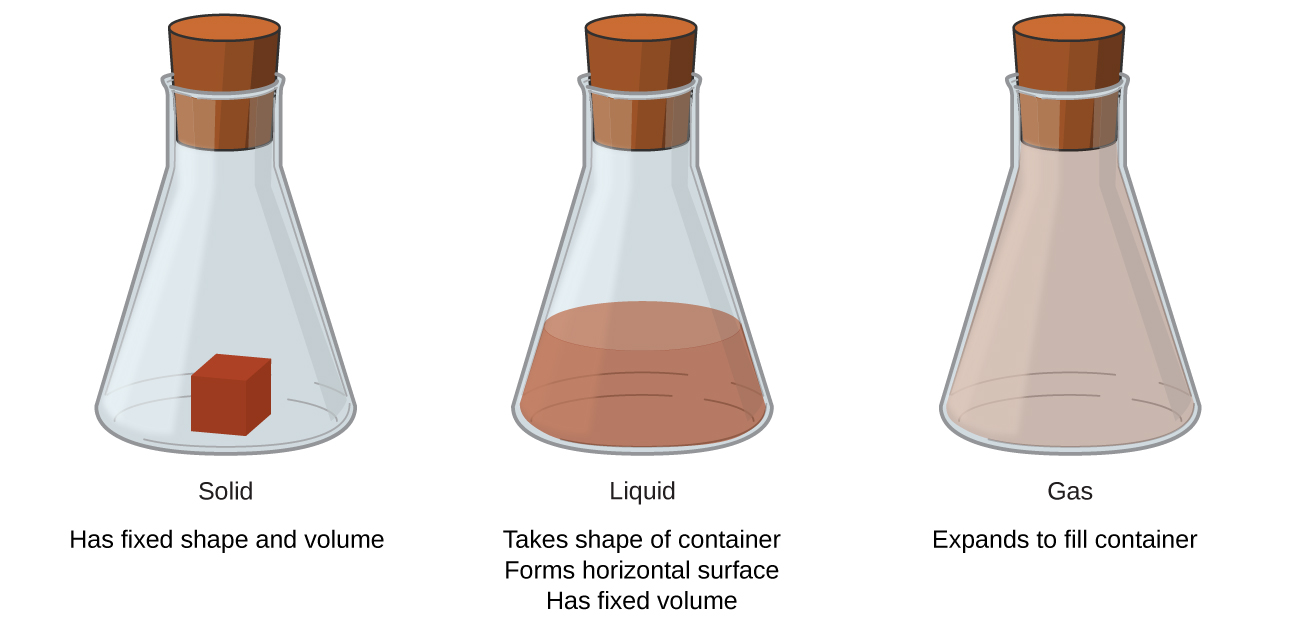
A fourth land of thing, plasma, occurs naturally in the interiors of stars. A plasma is a gaseous country of affair that contains observable numbers of electrically charged particles (Figure ii). The presence of these charged particles imparts unique properties to plasmas that justify their classification as a state of matter distinct from gases. In addition to stars, plasmas are found in another high-temperature environments (both natural and human-fabricated), such equally lightning strikes, certain idiot box screens, and specialized analytical instruments used to detect trace amounts of metals.
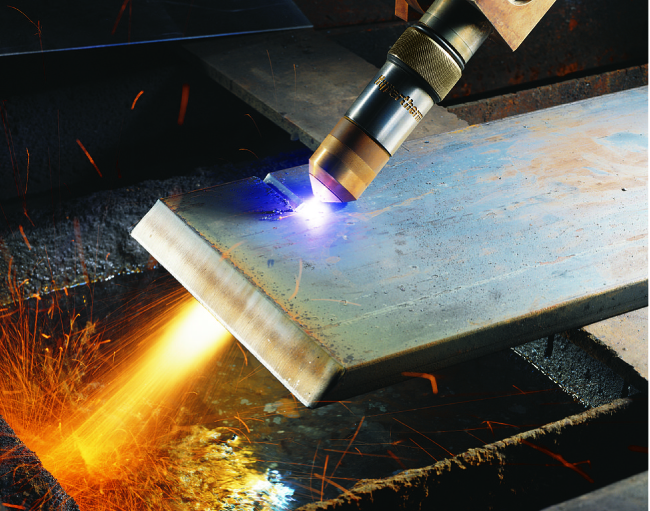

In a tiny cell in a plasma goggle box, the plasma emits ultraviolet light, which in plow causes the display at that location to appear a specific color. The composite of these tiny dots of colour makes up the image that you see. Watch this video to learn more about plasma and the places y'all run into it.
Some samples of thing appear to have properties of solids, liquids, and/or gases at the aforementioned time. This can occur when the sample is equanimous of many small pieces. For example, we tin cascade sand as if information technology were a liquid because it is composed of many small grains of solid sand. Matter can also accept properties of more than i land when it is a mixture, such as with clouds. Clouds appear to deport somewhat similar gases, merely they are really mixtures of air (gas) and tiny particles of h2o (liquid or solid).
The mass of an object is a mensurate of the corporeality of matter in it. One way to measure an object's mass is to measure the force it takes to accelerate the object. Information technology takes much more strength to accelerate a automobile than a bicycle because the motorcar has much more mass. A more mutual fashion to decide the mass of an object is to use a residual to compare its mass with a standard mass.
Although weight is related to mass, it is not the same affair. Weight refers to the strength that gravity exerts on an object. This force is directly proportional to the mass of the object. The weight of an object changes every bit the force of gravity changes, but its mass does not. An astronaut's mass does not change just because she goes to the moon. Just her weight on the moon is only i-sixth her earth-spring weight considering the moon's gravity is but i-sixth that of the world's. She may experience "weightless" during her trip when she experiences negligible external forces (gravitational or whatever other), although she is, of course, never "massless."
The police of conservation of matter summarizes many scientific observations about matter: Information technology states that there is no detectable change in the total quantity of matter present when matter converts from one type to some other (a chemic modify) or changes amongst solid, liquid, or gaseous states (a physical modify). Brewing beer and the operation of batteries provide examples of the conservation of thing (Figure iii). During the brewing of beer, the ingredients (water, yeast, grains, malt, hops, and sugar) are converted into beer (water, alcohol, carbonation, and flavoring substances) with no actual loss of substance. This is most clearly seen during the bottling process, when glucose turns into ethanol and carbon dioxide, and the total mass of the substances does not change. This can as well be seen in a lead-acid car battery: The original substances (lead, lead oxide, and sulfuric acid), which are capable of producing electricity, are changed into other substances (lead sulfate and water) that practise non produce electricity, with no change in the bodily corporeality of affair.
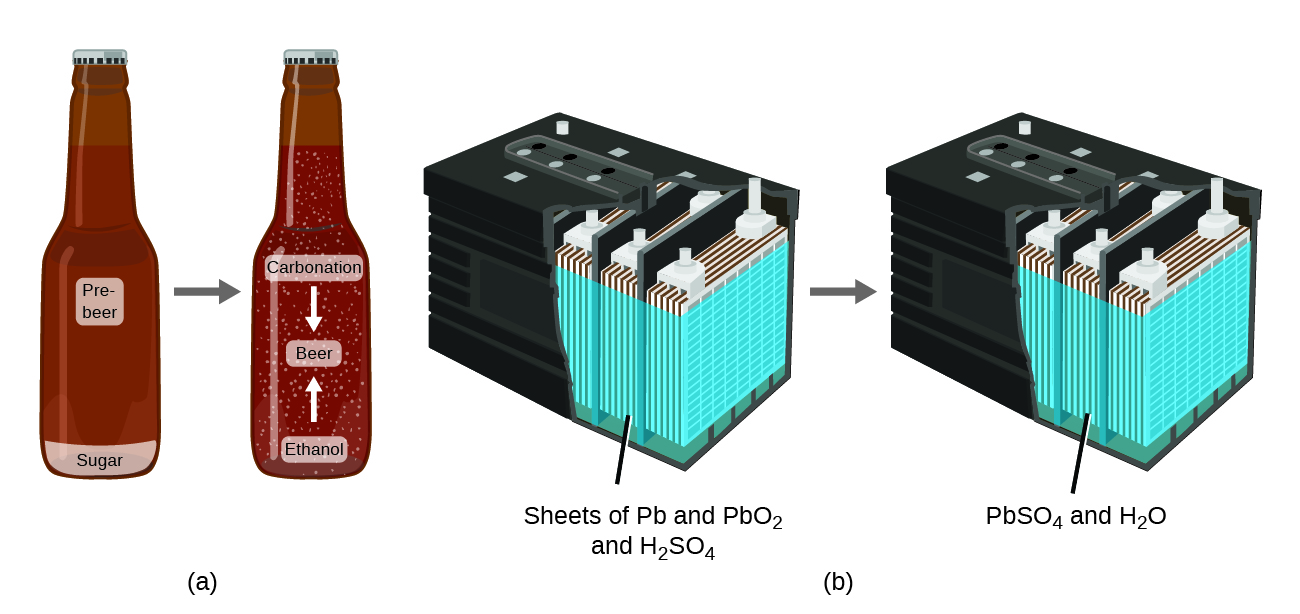
Although this conservation police force holds truthful for all conversions of matter, disarming examples are few and far between because, outside of the controlled conditions in a laboratory, we seldom collect all of the material that is produced during a particular conversion. For example, when y'all swallow, digest, and digest food, all of the affair in the original nutrient is preserved. But considering some of the matter is incorporated into your torso, and much is excreted as diverse types of waste product, it is challenging to verify by measurement.
Atoms and Molecules
An atom is the smallest particle of an element that has the properties of that element and tin can enter into a chemical combination. Consider the element golden, for example. Imagine cut a gold nugget in half, so cutting one of the halves in half, and repeating this process until a piece of golden remained that was so pocket-sized that it could not be cutting in half (regardless of how tiny your knife may be). This minimally sized piece of gold is an atom (from the Greek atomos, meaning "indivisible") (Effigy 4). This cantlet would no longer exist gold if it were divided any further.
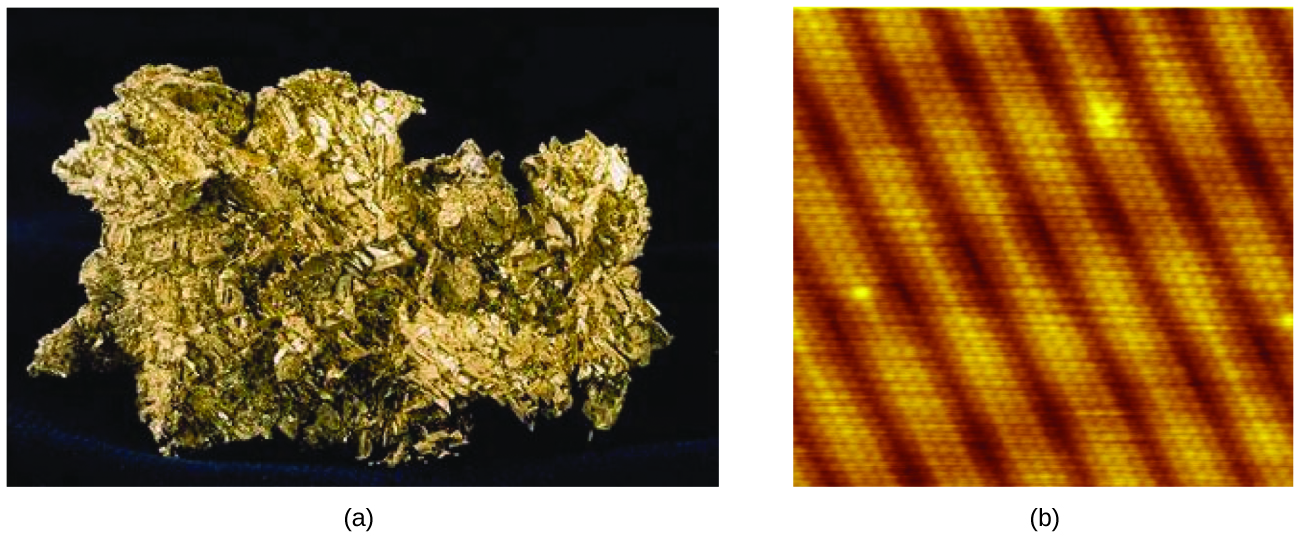
The get-go suggestion that matter is composed of atoms is attributed to the Greek philosophers Leucippus and Democritus, who developed their ideas in the 5th century BCE. However, information technology was not until the early on nineteenth century that John Dalton (1766–1844), a British schoolteacher with a corking interest in scientific discipline, supported this hypothesis with quantitative measurements. Since that time, repeated experiments have confirmed many aspects of this hypothesis, and it has go 1 of the central theories of chemical science. Other aspects of Dalton's atomic theory are still used simply with minor revisions (details of Dalton's theory are provided in the chapter on atoms and molecules).
An atom is so small that its size is hard to imagine. One of the smallest things we can come across with our unaided eye is a single thread of a spider spider web: These strands are about ane/ten,000 of a centimeter (0.0001 cm) in diameter. Although the cross-section of i strand is about impossible to meet without a microscope, it is huge on an atomic scale. A unmarried carbon atom in the web has a diameter of about 0.000000015 centimeter, and it would take about 7000 carbon atoms to span the diameter of the strand. To put this in perspective, if a carbon atom were the size of a dime, the cross-section of 1 strand would exist larger than a football field, which would crave almost 150 million carbon atom "dimes" to cover it. (Figure 5) shows increasingly close microscopic and atomic-level views of ordinary cotton.

An atom is so light that its mass is besides difficult to imagine. A billion lead atoms (1,000,000,000 atoms) weigh almost 3 × 10−13 grams, a mass that is far likewise lite to be weighed on even the world's most sensitive balances. It would crave over 300,000,000,000,000 lead atoms (300 trillion, or iii × 1014) to be weighed, and they would weigh only 0.0000001 gram.
It is rare to find collections of private atoms. Simply a few elements, such as the gases helium, neon, and argon, consist of a collection of individual atoms that movement about independently of one another. Other elements, such as the gases hydrogen, nitrogen, oxygen, and chlorine, are equanimous of units that consist of pairs of atoms (Effigy 6). One class of the element phosphorus consists of units composed of iv phosphorus atoms. The element sulfur exists in various forms, one of which consists of units equanimous of eight sulfur atoms. These units are called molecules. A molecule consists of ii or more than atoms joined by strong forces called chemic bonds. The atoms in a molecule movement around as a unit, much like the cans of soda in a six-pack or a bunch of keys joined together on a unmarried key ring. A molecule may consist of two or more than identical atoms, as in the molecules institute in the elements hydrogen, oxygen, and sulfur, or it may consist of two or more unlike atoms, as in the molecules found in water. Each water molecule is a unit that contains ii hydrogen atoms and one oxygen cantlet. Each glucose molecule is a unit that contains 6 carbon atoms, 12 hydrogen atoms, and half-dozen oxygen atoms. Like atoms, molecules are incredibly small and light. If an ordinary drinking glass of water were enlarged to the size of the earth, the water molecules inside it would be about the size of golf balls.

Classifying Thing
We can classify affair into several categories. Ii broad categories are mixtures and pure substances. A pure substance has a constant limerick. All specimens of a pure substance accept exactly the aforementioned makeup and properties. Any sample of sucrose (table sugar) consists of 42.1% carbon, 6.5% hydrogen, and 51.4% oxygen by mass. Any sample of sucrose also has the aforementioned physical properties, such as melting point, color, and sweetness, regardless of the source from which it is isolated.
Nosotros tin can split pure substances into ii classes: elements and compounds. Pure substances that cannot be broken downwardly into simpler substances by chemical changes are called elements. Iron, silver, gilded, aluminum, sulfur, oxygen, and copper are familiar examples of the more than 100 known elements, of which about 90 occur naturally on the world, and two dozen or and so have been created in laboratories.
Pure substances that can be broken downwards by chemical changes are called compounds. This breakup may produce either elements or other compounds, or both. Mercury(Ii) oxide, an orangish, crystalline solid, can be broken down by heat into the elements mercury and oxygen (Figure 7). When heated in the absence of air, the compound sucrose is broken down into the element carbon and the chemical compound water. (The initial stage of this process, when the sugar is turning chocolate-brown, is known equally caramelization—this is what imparts the characteristic sweet and nutty flavor to caramel apples, caramelized onions, and caramel). Silver(I) chloride is a white solid that can be broken down into its elements, silver and chlorine, by absorption of lite. This belongings is the basis for the utilize of this chemical compound in photographic films and photochromic eyeglasses (those with lenses that darken when exposed to light).


Many compounds break down when heated. This site shows the breakdown of mercury oxide, HgO. Yous can as well view an case of the photochemical decomposition of silverish chloride (AgCl), the basis of early photography.
The properties of combined elements are different from those in the free, or uncombined, state. For example, white crystalline carbohydrate (sucrose) is a chemical compound resulting from the chemic combination of the element carbon, which is a black solid in ane of its uncombined forms, and the two elements hydrogen and oxygen, which are colorless gases when uncombined. Gratuitous sodium, an element that is a soft, shiny, metal solid, and complimentary chlorine, an element that is a yellow-light-green gas, combine to form sodium chloride (tabular array salt), a chemical compound that is a white, crystalline solid.
A mixture is composed of two or more types of affair that can be nowadays in varying amounts and can be separated by physical changes, such as evaporation (you will learn more about this later on). A mixture with a composition that varies from indicate to bespeak is called a heterogeneous mixture. Italian dressing is an case of a heterogeneous mixture (Figure 8). Its composition tin can vary because we tin make it from varying amounts of oil, vinegar, and herbs. Information technology is non the same from point to betoken throughout the mixture—one drib may be generally vinegar, whereas a dissimilar drop may be mostly oil or herbs because the oil and vinegar separate and the herbs settle. Other examples of heterogeneous mixtures are chocolate chip cookies (we tin can see the split bits of chocolate, nuts, and cookie dough) and granite (we can see the quartz, mica, feldspar, and more).
A homogeneous mixture, also called a solution, exhibits a uniform composition and appears visually the same throughout. An case of a solution is a sports drink, consisting of water, sugar, coloring, flavoring, and electrolytes mixed together uniformly (Figure 8). Each drop of a sports drink tastes the same considering each drop contains the same amounts of water, sugar, and other components. Notation that the composition of a sports potable tin vary—it could exist made with somewhat more or less sugar, flavoring, or other components, and withal be a sports drink. Other examples of homogeneous mixtures include air, maple syrup, gasoline, and a solution of table salt in water.

Although there are merely over 100 elements, tens of millions of chemic compounds consequence from dissimilar combinations of these elements. Each compound has a specific composition and possesses definite chemic and physical properties by which we tin can distinguish it from all other compounds. And, of course, there are innumerable ways to combine elements and compounds to course dissimilar mixtures. A summary of how to distinguish between the various major classifications of matter is shown in (Figure 9).
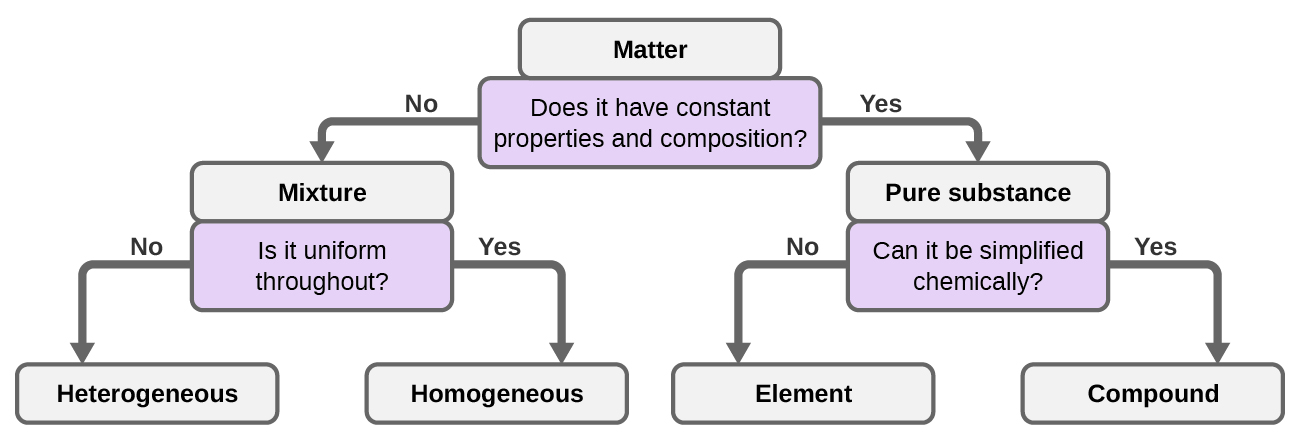
Eleven elements make up nearly 99% of the earth'due south crust and temper (Table 1). Oxygen constitutes virtually one-half and silicon near one-quarter of the total quantity of these elements. A bulk of elements on earth are found in chemical combinations with other elements; most one-quarter of the elements are besides constitute in the gratis state.
| Element | Symbol | Per centum Mass | Chemical element | Symbol | Percent Mass | |
|---|---|---|---|---|---|---|
| oxygen | O | 49.20 | chlorine | Cl | 0.19 | |
| silicon | Si | 25.67 | phosphorus | P | 0.11 | |
| aluminum | Al | 7.fifty | manganese | Mn | 0.09 | |
| atomic number 26 | Fe | 4.71 | carbon | C | 0.08 | |
| calcium | Ca | three.39 | sulfur | South | 0.06 | |
| sodium | Na | 2.63 | barium | Ba | 0.04 | |
| potassium | K | two.twoscore | nitrogen | N | 0.03 | |
| magnesium | Mg | 1.93 | fluorine | F | 0.03 | |
| hydrogen | H | 0.87 | strontium | Sr | 0.02 | |
| titanium | Ti | 0.58 | all others | – | 0.47 | |
| Table 1. Elemental Composition of Earth | ||||||
Decomposition of Water / Production of Hydrogen
Water consists of the elements hydrogen and oxygen combined in a ii to one ratio. H2o can exist broken down into hydrogen and oxygen gases by the addition of free energy. One way to do this is with a battery or power supply, as shown in (Figure 10).
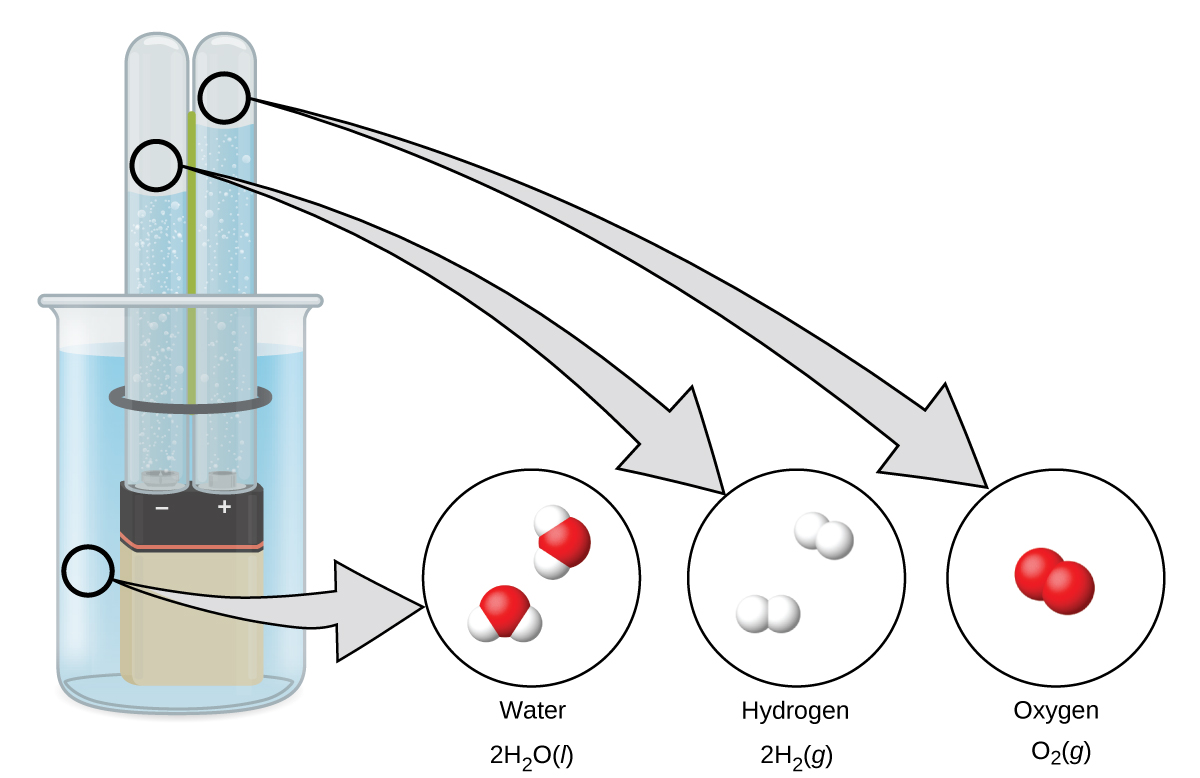
The breakdown of water involves a rearrangement of the atoms in water molecules into different molecules, each equanimous of two hydrogen atoms and two oxygen atoms, respectively. Ii water molecules form one oxygen molecule and two hydrogen molecules. The representation for what occurs, [latex]ii\text{H}_2\text{O}(l) \rightarrow 2\text{H}_2(thou) + \text{O}_2(m)[/latex], will be explored in more depth in later chapters.
The two gases produced have distinctly different backdrop. Oxygen is not flammable but is required for combustion of a fuel, and hydrogen is highly flammable and a stiff energy source. How might this knowledge exist applied in our world? One application involves research into more fuel-efficient transportation. Fuel-prison cell vehicles (FCV) run on hydrogen instead of gasoline (Figure 11). They are more than efficient than vehicles with internal combustion engines, are nonpolluting, and reduce greenhouse gas emissions, making us less dependent on fossil fuels. FCVs are not nonetheless economically viable, however, and current hydrogen product depends on natural gas. If we tin can develop a process to economically decompose water, or produce hydrogen in another environmentally sound manner, FCVs may be the manner of the hereafter.
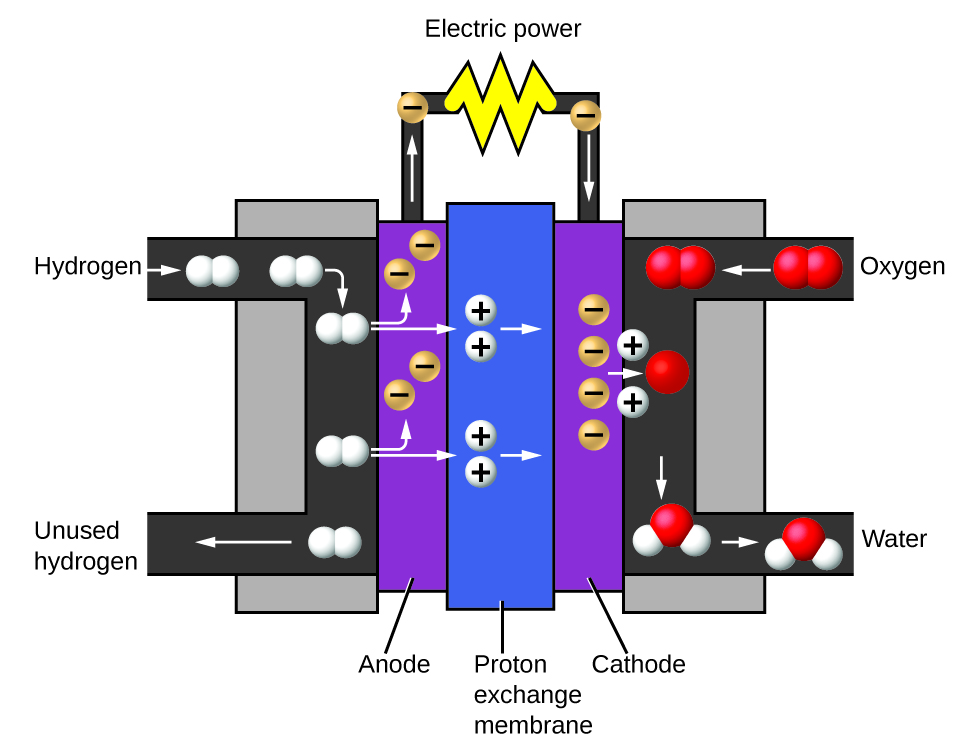
Chemistry of Jail cell Phones
Imagine how different your life would be without cell phones (Effigy 12) and other smart devices. Cell phones are fabricated from numerous chemical substances, which are extracted, refined, purified, and assembled using an extensive and in-depth understanding of chemical principles. Near 30% of the elements that are found in nature are found inside a typical smart telephone. The case/body/frame consists of a combination of sturdy, durable polymers comprised primarily of carbon, hydrogen, oxygen, and nitrogen [acrylonitrile butadiene styrene (ABS) and polycarbonate thermoplastics], and calorie-free, stiff, structural metals, such equally aluminum, magnesium, and iron. The display screen is fabricated from a specially toughened glass (silica glass strengthened by the addition of aluminum, sodium, and potassium) and coated with a material to brand information technology conductive (such as indium tin oxide). The excursion board uses a semiconductor fabric (usually silicon); commonly used metals like copper, can, argent, and gold; and more unfamiliar elements such as yttrium, praseodymium, and gadolinium. The bombardment relies upon lithium ions and a diverseness of other materials, including iron, cobalt, copper, polyethylene oxide, and polyacrylonitrile.
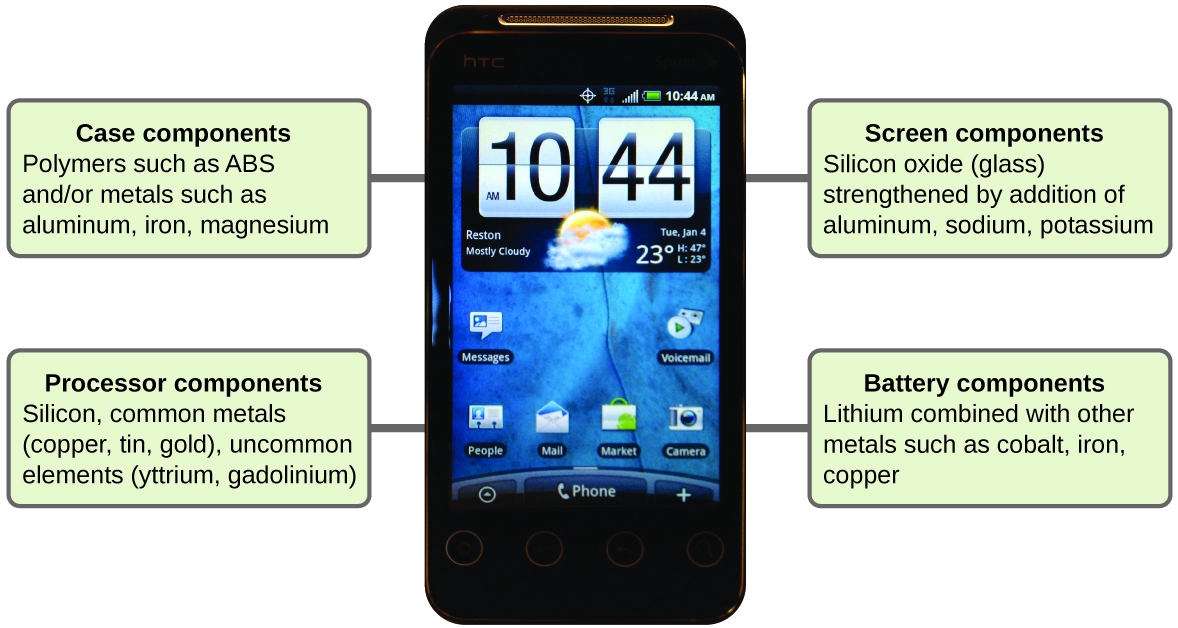
Primal Concepts and Summary
Matter is anything that occupies infinite and has mass. The basic building block of thing is the atom, the smallest unit of an element that can enter into combinations with atoms of the same or other elements. In many substances, atoms are combined into molecules. On earth, matter ordinarily exists in three states: solids, of stock-still shape and volume; liquids, of variable shape but fixed volume; and gases, of variable shape and volume. Under high-temperature weather, matter also can exist as a plasma. Most matter is a mixture: It is composed of ii or more types of matter that can be present in varying amounts and tin be separated past physical means. Heterogeneous mixtures vary in composition from point to indicate; homogeneous mixtures accept the same composition from indicate to point. Pure substances consist of only one blazon of matter. A pure substance tin can exist an element, which consists of only one type of atom and cannot be broken down past a chemical change, or a chemical compound, which consists of two or more types of atoms.
Chemistry Cease of Affiliate Exercises
- Why exercise nosotros use an object's mass, rather than its weight, to indicate the amount of matter it contains?
- What properties distinguish solids from liquids? Liquids from gases? Solids from gases?
- How does a heterogeneous mixture differ from a homogeneous mixture? How are they similar?
- How does a homogeneous mixture differ from a pure substance? How are they similar?
- How does an element differ from a compound? How are they similar?
- How do molecules of elements and molecules of compounds differ? In what ways are they similar?
- How does an cantlet differ from a molecule? In what ways are they similar?
- Many of the items you purchase are mixtures of pure compounds. Select three of these commercial products and prepare a listing of the ingredients that are pure compounds.
- Allocate each of the following as an element, a compound, or a mixture:
(a) copper
(b) water
(c) nitrogen
(d) sulfur
(e) air
(f) sucrose
(g) a substance equanimous of molecules each of which contains two iodine atoms
(h) gasoline
- Classify each of the post-obit as an chemical element, a compound, or a mixture:
(a) fe
(b) oxygen
(c) mercury oxide
(d) pancake syrup
(due east) carbon dioxide
(f) a substance equanimous of molecules each of which contains one hydrogen cantlet and one chlorine atom
(yard) baking soda
(h) baking powder
- A sulfur cantlet and a sulfur molecule are not identical. What is the difference?
- How are the molecules in oxygen gas, the molecules in hydrogen gas, and water molecules similar? How do they differ?
- We refer to astronauts in infinite equally weightless, simply not without mass. Why?
- Equally we drive an automobile, we don't remember about the chemicals consumed and produced. Set a list of the principal chemicals consumed and produced during the functioning of an machine.
- Thing is everywhere around us. Make a listing by name of fifteen different kinds of thing that you see every day. Your list should include (and label at least one case of each) the following: a solid, a liquid, a gas, an element, a compound, a homogenous mixture, a heterogeneous mixture, and a pure substance.
- When elemental iron corrodes it combines with oxygen in the air to ultimately class red brown iron(Iii) oxide which we call rust. (a) If a shiny iron nail with an initial mass of 23.2 g is weighed after beingness coated in a layer of rust, would you expect the mass to have increased, decreased, or remained the aforementioned? Explicate. (b) If the mass of the iron nail increases to 24.1 g, what mass of oxygen combined with the iron?
- As stated in the text, convincing examples that demonstrate the law of conservation of affair outside of the laboratory are few and far between. Point whether the mass would increase, decrease, or stay the same for the following scenarios where chemic reactions have place:
(a) Exactly 1 pound of breadstuff dough is placed in a blistering tin. The dough is cooked in an oven at 350 °F releasing a wonderful aroma of freshly baked bread during the cooking process. Is the mass of the baked loaf less than, greater than, or the same as the 1 pound of original dough? Explain.
(b) When magnesium burns in air a white flaky ash of magnesium oxide is produced. Is the mass of magnesium oxide less than, greater than, or the same as the original slice of magnesium? Explain.
(c) Antoine Lavoisier, the French scientist credited with kickoff stating the law of conservation of matter, heated a mixture of tin and air in a sealed flask to produce tin can oxide. Did the mass of the sealed flask and contents decrease, increment, or remain the aforementioned after the heating?
- Yeast converts glucose to ethanol and carbon dioxide during anaerobic fermentation as depicted in the simple chemical equation here:
[latex]\text{glucose} \rightarrow \text{ethanol + carbon dioxide}[/latex]
(a) If 200.0 g of glucose is fully converted, what will exist the total mass of ethanol and carbon dioxide produced?
(b) If the fermentation is carried out in an open container, would you expect the mass of the container and contents after fermentation to be less than, greater than, or the aforementioned as the mass of the container and contents earlier fermentation? Explain.
(c) If 97.7 1000 of carbon dioxide is produced, what mass of ethanol is produced?
Glossary
- cantlet
- smallest particle of an chemical element that can enter into a chemical combination
- chemical compound
- pure substance that tin can be decomposed into ii or more than elements
- element
- substance that is composed of a unmarried type of cantlet; a substance that cannot be decomposed past a chemical alter
- gas
- country in which thing has neither definite volume nor shape
- heterogeneous mixture
- combination of substances with a composition that varies from bespeak to signal
- homogeneous mixture
- (also, solution) combination of substances with a composition that is uniform throughout
- liquid
- state of matter that has a definite volume but indefinite shape
- law of conservation of affair
- when matter converts from 1 blazon to another or changes form, at that place is no detectable change in the total amount of matter nowadays
- mass
- cardinal holding indicating corporeality of matter
- thing
- annihilation that occupies space and has mass
- mixture
- matter that can exist separated into its components by physical means
- molecule
- bonded collection of two or more atoms of the aforementioned or dissimilar elements
- plasma
- gaseous country of matter containing a big number of electrically charged atoms and/or molecules
- pure substance
- homogeneous substance that has a abiding composition
- solid
- state of matter that is rigid, has a definite shape, and has a fairly constant volume
- weight
- strength that gravity exerts on an object
Solutions
Answers for Chemistry End of Chapter Exercises
2. Liquids can change their shape (menstruation); solids can't. Gases tin can undergo large book changes as pressure changes; liquids exercise not. Gases flow and change volume; solids do not.
four. The mixture can take a diverseness of compositions; a pure substance has a definite composition. Both have the aforementioned composition from point to betoken.
vi. Molecules of elements contain only one type of atom; molecules of compounds incorporate ii or more types of atoms. They are similar in that both are comprised of two or more atoms chemically bonded together.
viii. Answers will vary. Sample reply: Gatorade contains water, carbohydrate, dextrose, citric acid, table salt, sodium chloride, monopotassium phosphate, and sucrose acetate isobutyrate.
10. (a) element; (b) element; (c) compound; (d) mixture, (e) compound; (f) chemical compound; (g) compound; (h) mixture
12. In each case, a molecule consists of two or more combined atoms. They differ in that the types of atoms change from one substance to the next.
14. Gasoline (a mixture of compounds), oxygen, and to a lesser extent, nitrogen are consumed. Carbon dioxide and water are the primary products. Carbon monoxide and nitrogen oxides are produced in lesser amounts.
16. (a) Increased every bit it would take combined with oxygen in the air thus increasing the amount of matter and therefore the mass. (b) 0.9 g
18. (a) 200.0 thousand; (b) The mass of the container and contents would decrease as carbon dioxide is a gaseous production and would leave the container. (c) 102.3 grand
Source: https://opentextbc.ca/chemistry/chapter/phases-and-classification-of-matter/
0 Response to "Unit 2 Lesson 5 Review Science Mixture and Compounds"
Post a Comment